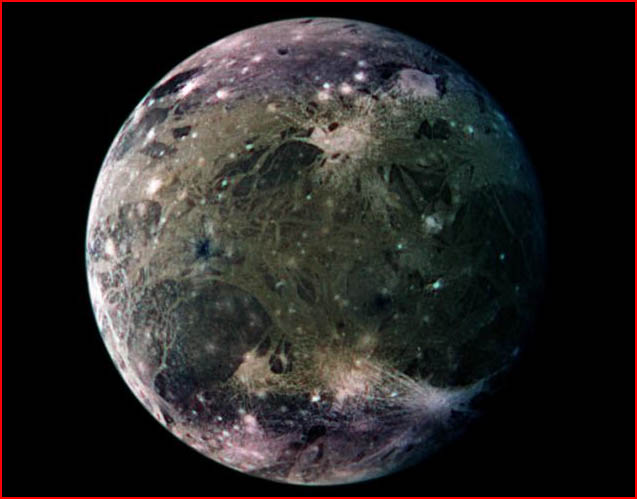
home •
about •
essential guide •
picture of the day •
thunderblogs •
news •
multimedia •
predictions •
products •
get involved •
contact
picture of the day archive subject index
Ganymede, the third moon from Jupiter and the largest planetary satellite in the solar system
Credit: NASA/JP
Aug 15, 2007
Ganymede Bears WitnessThe solar system's largest moon shows signs of what could be electric scarring. Is plasma discharge responsible for the topography we see?
Jupiter and its moons have been the destination of several remote observation platforms launched over the last three decades. Beginning with Pioneer 10 in 1973 and including the most recent visit by New Horizons this year, seven different camera packages have flown past the planet and many of its moons. Of all the moons, Ganymede is possibly the most exotic, with a wild mix of topography, fractures, craters and sinuous rilles.
Ganymede is unique among moons in that it has a magnetic field surrounding it, something even Mars does not possess. In December 1995, the Galileo spacecraft entered orbit around Jupiter. During a flyby of Ganymede at an altitude of only 838 kilometers, Galileo discovered a dipole magnetic field very much like the one surrounding Earth. As with Io, the signature of Ganymede's flux tube, the electric current that connects it with Jupiter, can be seen in the aurora at the poles.
With a mean diameter of 5262 kilometers, Ganymede is the largest moon orbiting any planet and is the fourth largest rocky object after the planet Mars. The magnetic field is supposedly being created by the moon's core in a "dynamo" of sorts - once again like the Earth's core is supposed to be generating its magnetic field. There is an ambiguity, however. Ganymede's core is too hot to hold on to permanent magnetism. But Ganymede is so small that, according to conventional astro-geology, it should have cooled off billions of years ago and should not have a liquid core in the first place.
The ad hoc explanation that NASA scientists have announced creates its own conundrum, though.
The moon once may have been much closer to Jupiter, so it was alternately compressed and stretched by the tidal forces of the planet's gravitational field. The constant kneading of the moon kept its core liquid for much longer than if it had formed in its present orbit. If that were the case, then what forced an object bigger than the planet Mercury to move into a new orbit? Was any thought given to a mechanism for moving several quintillion tons of rock and ice a few thousand kilometers against the force of Jupiter's gravity?
Of course, the most obvious aspect of Ganymede's bizarre nature is its surface and the manifold examples of apparent electric discharge machining (EDM). Previous Thunderbolts Picture of the Day articles presented evidence for the hypothesis by showing how crater chains form on Ganymede and other planets and moons. Another likely example of EDM is the huge circular structure dominating an entire hemisphere. Within the darkened circle, several bright craters are arrayed in a spiral shape that gradually decreases in diameter toward the center. Some craters have rays extending outward for several kilometers in all directions. Several have one or more nested concentrically within the other. Such features require a chain of unlikely coincidences if mechanical impacts are to explain them, but EDM creates such scars naturally.
Could the magnetic field of Ganymede be related to the electrical phenomena that have scarred and transmogrified it? If Ganymede was indeed closer to Jupiter at some point in its past and was then wrenched from orbit and thrown thousands of kilometers further out from the tidal grasp of its parent, could the force that was responsible for that event have been electrical in nature? Was the moon gripped by an electrodynamic field large enough to imprint its core with permanent magnetism? What effect does the electrical connection with Jupiter have on Ganymede today?
NASA plans more missions to the moons of Jupiter in the next ten years. As more data is returned from a growing number of deep space probes, perhaps the evidence for electric effects will help to increase awareness for electricity in space.
By Stephen Smith
___________________________________________________________________________Please visit our Forum
The Electric Sky and The Electric Universe available now!

|
|

|
EXECUTIVE EDITORS:
David Talbott, Wallace Thornhill
MANAGING EDITORS:
Steve Smith, Mel Acheson
CONTRIBUTING EDITORS: Michael Armstrong, Dwardu Cardona,
Ev Cochrane,
C.J. Ransom, Don Scott, Rens van der Sluijs, Ian Tresman
WEBMASTER: Brian Talbott
Copyright 2007: thunderbolts.info
![]()
home •
thunderblogs •
forum •
picture of the day •
resources •
team •
updates •
contact us

